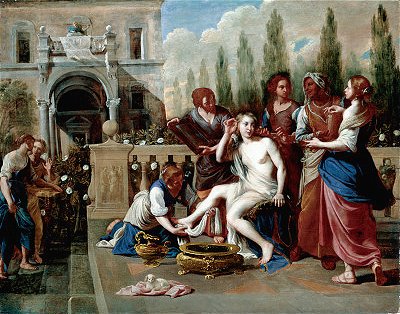 |
|
Bathsheba at her Bath
Painting by Domenico Gargiulo
By Carolyn Jackson. Docent. 2000
Neophytes:
In this painting we see 9 people. At the right, on an outdoor terrace, four women surround
a seated woman, unclothed, but loosely draped in transparent material. A fifth woman is
kneeling at her feet and appears to be washing them. In the foreground we see a small dog
lying on a pillow, and just behind, a golden pitcher and basin. To the left, ascending the
terrace steps, we see two women, one carrying a tray which appears to hold jewelry. In the
background, we see what appears to be a large building, on the balcony of which we can
barely discern a human figure. On the right, receding into the distance, we see a grove of
cypress trees. The light comes from the left, and focuses our attention on the seated
nude. |
Novices:
The title of the painting is Bathsheba at her Bath, and according to the biblical account
we know that it is King David who is watching Bathsheba and her attendants from his palace
balcony. Bathsheba was the wife of Uriah the Hittite, one of David's generals; she was
seduced by David. She became his wife after he deliberately sent Uriah to his death in
battle. God's displeasure over David's behavior is seen when the child conceived in their
affair dies in infancy. Solomon, their fourth child, with the help of Bathsheba, succeeded
David to the throne.
The figures in this painting appear natural in their idealized setting. The attendants and
even the seated Bathsheba exhibit a sense of movement in their postures and the expression
in their faces. Light provides a dramatic focus for the eyes as it directs our attention
to the figure of Bathsheba. The golden objects in the foreground and the pearl jewelry
show the artist's attention to detail; the small dog adds another naturalistic touch to
the scene. The setting and the architecture are classical in feel.
Advanced Amateur (Expert):
The artist is Domenico Gargiulo. He was also known by the nickname Spadera, since his
father was a maker of swords or spadera. Gargiulo's art illustrates both the naturalism
and idealism of Italian seventeenth century high baroque painting. He collaborated with a
number of other painters of his time and exhibits contradictory styles. This painting is
considered a collaborative effort. Gargiulo is known for the spirit of imaginative fantasy
that enlivens his works.
To the right is a second painting by Gargiulo, The Israelites Celebrating David's Return,
which is most likely another collaboration. Art historians believe that the two works may
be part of a series of Neapolitan paintings depicting scenes in the life of David.
Additional information:
Gargiulo, Domenico (Known as Spadaro, Micco)
B.Naples, 1609-10; D. Naples ?1675. Italian painter and draughtsman. Nicknamed Micco
Spadaro because his father was a maker of swords (spade).
From about 1628, Spadaro trained in the workshop of Aniello Falcone. With fellow student
Salvator Rosa, he painted landscapes in the open air in the Neapolitan countryside. These
early works were influenced by Paul Bril's frescoes and the vivid realism of Filippo
Napoletano.
Spadaro's earliest known works are close in style to contemporary Roman
"bambocciate" painting. The name derives from Pieter van Laer, called il
Bamboccio, whose specialty was small works representing trivial or everyday subjects of
contemporary Italian life. Except for native Roman Michelangelo Cerquozzi, the principal
Bamboccianti were all of Dutch, Flemish, German or French origin, and they had a profound
influence on painting of this type in the Netherlands and 18th century Italy.
The freshness and spontaneity of Spadaro's commissioned frescoed landscapes is attributed
to his sketching expeditions around Naples; In this period, around 1640, Spadaro
frequently collaborated with Viuviano Codazzi on pictures in which the architectural
perspectives were painted by Codazzi and the figures by Spadaro.
Spadaro was susceptible to the influence of other painters, which partly explains his
diverse and even contradictory stylistic tendencies. His many paintings of Old Testament
scenes and martyrdom, such as the Martyrdaom of St. Stephens, are crowded with small,
elegantly gesticulating figures set in wild landscapes enriched with ruined Classical
architecture. His ambitious attempts at monumental pictures, such as Virgin and Child with
Saints John and Paul (late 1640's) are weak evocations of Massimo Stanzione's classicizing
manner.
Only in his later years, did Spadaro achieve a definitive personal style with his
celebrated paintings of important episodes from Neapolitan history painted between l656
and 1660; all these works show topographically accurate views of parts of the city, filled
with crowds of ordinary people, among whom the protagonists of the historical dramas
mingle.
In addition to his narrative talent, Spadaro enjoyed adding interesting, and at times
amusing, details with a real feeling for pictorial immediacy. His other works of the same
period - "bambocciate,' mythological and religious scenes -all much in demand among
connoisseurs - are often animated by a spirit of imaginative fantasy.
|